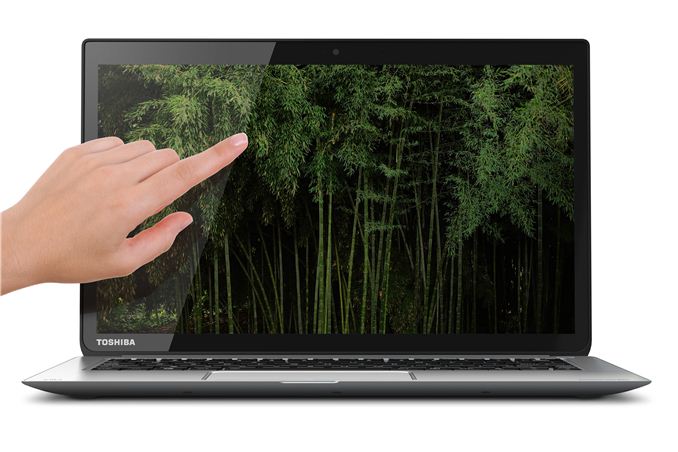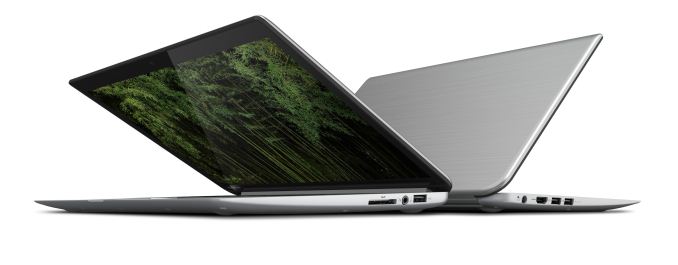Toshiba's New KIRAbook Brings QHD to the Windows PC
by Dustin Sklavos on April 18, 2013 12:00 AM EST
I recently had an opportunity to take a meeting with Toshiba in San Francisco. Meetings with reps from major notebook vendors are oftentimes an exercise in enthusiasm coupled with frustration; I usually like the direction a company is taking their designs (Toshiba in particular still never seems to get the attention they deserve when HP and Dell continue to languish, chasing their tails), and then when I ask for the speeds and feeds the display is invariably 1366x768. Cue the lecture.
That's why Toshiba's KIRAbook was such a welcome surprise. It's a good looking ultrabook, employing a magnesium alloy shell and Corning Concore Glass, and if it's not exceptionally original in its aesthetic it's at least very well built and specced to please. I'll get into details about its fit and finish later, but for now, all you need to know is this:
13.3" IPS 2560x1440 display. Standard.
It's true we're still essentially stuck with the 16:9 aspect ratio on the PC side while Apple's 13" Retina MacBook Pro offers a 2560x1600 panel, but this is still a very welcome change of pace.
As for the rest of the KIRAbook, Toshiba's reps talked a heavy game about its design and for what it's worth, they raise excellent points. The port layout is smart, the keyboard was designed specifically to avoid backlight bleed from the individual keys, and they're using specially engineered Harmon Kardon speakers that are surprisingly loud for such a slim chassis. Impressively, the whole thing is just 2.6 pounds.
Unfortunately it all comes at a price. The starting model is $1,599 and comes with an Intel Core i5 ULV processor; upgrading to the $1,799 model gets you 10-point multitouch on the display, and the $1,999 model adds an upgrade to a Core i7.
You do get 8GB of DDR3-1600, the QHD IPS display, a 50Wh battery, and a 256GB SSD standard in all models, along with useful Adobe Photoshop Elements 11 and Premiere Elements 11 pack-in software and a standard two-year warranty with 24/7 phone support and basically a dedicated department specifically for handling and servicing KIRA models (it's safe to assume more are en route.) Examining the model, I also found that the bottom panel uses standard Phillips head screws, so theoretically you can swap out the SSD and wireless card, though the RAM is probably soldered to the motherboard.
Either way, we're looking to have a KIRAbook in house for review in time for launch, so stay tuned. Pre-orders start May 3, and the KIRAbook becomes available for purchase on May 12.


















46 Comments
View All Comments
sherlockwing - Thursday, April 18, 2013 - link
That is an issue. But given a 50Whr Battery(13" rMBP have a 74Whr Battery), using ULV i5 is the only way for the battery life of this Toshiba to be even comparable to rMBP.Khato - Thursday, April 18, 2013 - link
The source of the Retina MBP 13" performance problems is the OS, not the GPU. I'd thought this to be the case considering that Intel's HD 4000 supports 4k display resolutions, but it's easy enough to test! Hooked my media computer with an i5-3570k using the integrated graphics up to my U2713HM by displayport and there are no visible issues in Windows 7. Oh, and the GPU-z sensor tab is reporting that the GPU core clock stays at the 350MHz floor.madmilk - Sunday, April 21, 2013 - link
A lot of the performance problems is actually bad applications. For example, Google Chrome has very poor scrolling performance at high zoom levels, which is effectively what HiDPI mode is. Both Safari and Firefox are much better, but many people automatically assume Chrome is the fastest when it is not.ShieTar - Thursday, April 18, 2013 - link
About a year ago I built a System with a Sandy Bridge Celeron with HD2000 graphic as an inexpensive home office & media player box for a friend of mine going to college. For the installation part, and just to test it a little, I had it connected to my own 2560x1600 main screen and the 900x1600 secondary screen on my desktop. There was absolutely no framerate troubles on this combined 3460x1600 desktop in anything I have tested it with, be it surfing the internet, watching Blueray-Movies, viewing PDF-Documents with loads of vector-graphics, working on large word-documents, you name it.Of course it would fail horribly at playing games or as a CAD-Station, but for a very large part of usage scenarios, HD2000 is fine, and HD4000 is more than enough.
MonkeyPaw - Thursday, April 18, 2013 - link
I also don't understand the concern with the IGP. The last two retina iPads have lots of pixels that are driven by a SOC with a lower TDP than a Core i5. It's all about bandwidth, and dual channel DDR 1600 is quite sufficient in that regard. I wouldn't expect gaming at native res, but Windows will run just fine.tipoo - Thursday, April 18, 2013 - link
The resolution doesn't choke up that IGP, they can be a lot weaker than the HD4000 and run that resolution. The problem with the Retina models was the additional scaling they need for the retina tech, it has to render at two different resolutions then downscale etc.peterfares - Tuesday, April 30, 2013 - link
I've driven a 2560x1600 monitor with no issues on my X230 with an Intel HD 3000 graphics. Heck, even my old first-gen i5 EliteBook 2740p drove that monitor without any framerate issues. Maybe Mac OS just doesn't work well with Intel graphics and high resolution screens?Mayuyu - Thursday, April 18, 2013 - link
Death Note?dgingeri - Thursday, April 18, 2013 - link
yes, they did essentially name this thing "Killerbook" but with a little Japanese flair just so they wouldn't get sued for a different trademark infringement.jramskov - Thursday, April 18, 2013 - link
GPU performance is certainly a concern (perhaps it will be best to wait for Haswell to arrive?) and so is battery life, but I would also very much like to see a 16GB memory option.